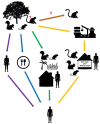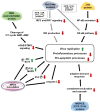Animal Models Used in Monkeypox Research
- PMID: 36363786
- PMCID: PMC9694439
- DOI: 10.3390/microorganisms10112192
Animal Models Used in Monkeypox Research
Abstract
Monkeypox is an emerging zoonotic disease with a growing prevalence outside of its endemic area, posing a significant threat to public health. Despite the epidemiological and field investigations of monkeypox, little is known about its maintenance in natural reservoirs, biological implications or disease management. African rodents are considered possible reservoirs, although many mammalian species have been naturally infected with the monkeypox virus (MPXV). The involvement of domestic livestock and pets in spillover events cannot be ruled out, which may facilitate secondary virus transmission to humans. Investigation of MPXV infection in putative reservoir species and non-human primates experimentally uncovered novel findings relevant to the course of pathogenesis, virulence factors and transmission of MPXV that provided valuable information for designing appropriate prevention measures and effective vaccines.
Keywords: animal models; emerging infectious diseases; monkeypox virus; reservoir; vaccine; zoonosis.
Conflict of interest statement
The authors declare no conflict of interest.
Figures



References
Publication types
LinkOut - more resources
Full Text Sources

